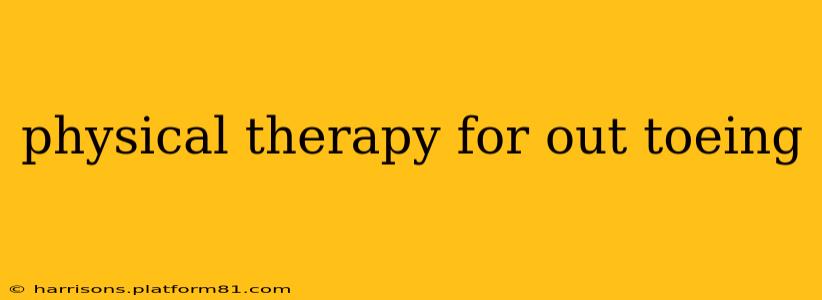Out-toeing, also known as external tibial torsion, is a condition where the feet turn outward when walking. While often harmless, particularly in young children, persistent out-toeing can affect gait, balance, and even lead to discomfort in the knees, hips, and lower back. Physical therapy plays a significant role in correcting out-toeing, especially when underlying causes exist. This comprehensive guide explores the various aspects of physical therapy for out-toeing.
What Causes Out-Toeing?
Understanding the root cause of out-toeing is crucial for determining the most effective treatment. Several factors can contribute to this condition:
- Developmental factors: In infants and young children, out-toeing can be a normal developmental phase. The bones and muscles are still developing, and the feet may naturally point outward. This often resolves itself as the child grows.
- Genetic factors: Family history of foot alignment issues can increase the risk of out-toeing.
- Underlying medical conditions: Certain neuromuscular conditions or skeletal abnormalities can cause or contribute to out-toeing.
- Footwear: Inappropriate footwear, especially shoes that are too tight or restrict natural foot movement, can influence foot alignment.
- Postural habits: Poor posture or habitual ways of standing and walking can reinforce out-toeing.
What Does Physical Therapy for Out-Toeing Involve?
Physical therapy for out-toeing focuses on improving foot alignment, strengthening supporting muscles, and improving overall gait. Treatment plans are tailored to the individual's age, the severity of out-toeing, and the underlying cause. Common interventions include:
- Stretching exercises: These exercises target the muscles in the hips, thighs, and ankles to improve flexibility and reduce tightness that can contribute to out-toeing. Examples include hip flexor stretches, hamstring stretches, and calf stretches.
- Strengthening exercises: Specific exercises strengthen the muscles that support the legs and feet. This helps stabilize the ankles and improve the ability to control foot position during movement. Exercises might focus on strengthening the gluteal muscles, quadriceps, and calf muscles.
- Gait retraining: Physical therapists guide patients in improving their walking patterns to correct their foot alignment. This might involve using visual aids, mirrors, or other techniques to help individuals become aware of and correct their out-toeing.
- Proprioceptive exercises: These exercises improve balance and coordination, enhancing body awareness and helping control foot placement. Activities like standing on one leg, balance boards, and wobble boards are commonly used.
- Orthotics: In some cases, custom orthotics (shoe inserts) may be recommended to support the feet and help maintain proper alignment.
What are the Benefits of Physical Therapy for Out-Toeing?
The benefits of physical therapy for out-toeing extend beyond simply correcting the foot alignment. Effective treatment can:
- Improve gait: Correcting out-toeing leads to a more efficient and natural walking pattern, reducing strain on joints and muscles.
- Enhance balance: Improved muscle strength and coordination enhance balance and reduce the risk of falls.
- Reduce pain: By addressing underlying muscle imbalances and improving alignment, physical therapy can alleviate pain in the knees, hips, and lower back often associated with out-toeing.
- Prevent future problems: Early intervention can prevent long-term complications associated with persistent out-toeing.
How Long Does Physical Therapy for Out-Toeing Take?
The duration of physical therapy varies depending on individual factors. In some cases, particularly with mild out-toeing in young children, improvement can be seen relatively quickly. More severe cases or those with underlying conditions may require a longer course of treatment. Regular attendance and adherence to the prescribed exercise program are essential for optimal results.
Does Physical Therapy Always Correct Out-Toeing?
While physical therapy is highly effective for many individuals with out-toeing, the success rate depends on several factors, including the severity of the condition, the underlying cause, and the patient's commitment to the treatment plan. In some cases, surgery might be considered if physical therapy doesn't yield sufficient improvement.
Can Out-Toeing Be Corrected in Adults?
Yes, out-toeing can often be corrected in adults, although the process may take longer compared to children. The treatment approach will be similar to that used in children, focusing on improving muscle flexibility, strength, and gait. The key is consistent effort and adherence to the physical therapist's recommendations.
What Exercises Can I Do at Home for Out-Toeing?
While a personalized plan from a physical therapist is recommended, some exercises you might consider include:
- Hip flexor stretches: Gentle stretches holding for 30 seconds, several times a day.
- Hamstring stretches: Reaching towards your toes while keeping your knees slightly bent.
- Calf stretches: Leaning against a wall with one leg straight and the other bent, feeling a stretch in the calf muscle.
- Glute bridges: Lying on your back, lifting your hips off the ground and squeezing your glutes.
Disclaimer: This information is for general knowledge and does not constitute medical advice. Always consult with a healthcare professional or physical therapist for diagnosis and treatment of out-toeing. They can assess your specific situation and create a personalized plan that addresses your individual needs.
